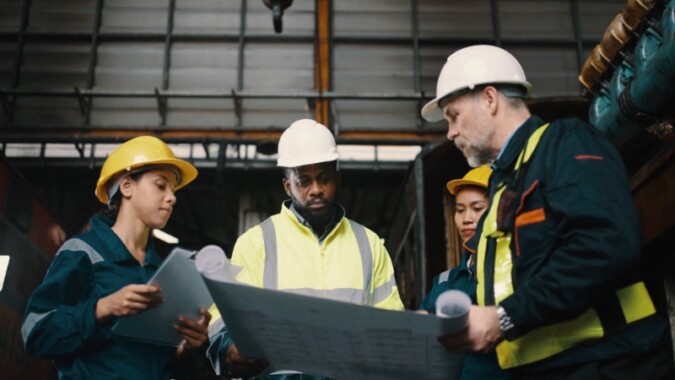Engineers who step into advanced industries rarely walk into a neat, linear world. The work happens in pressure zones where technical depth meets budgets, safety checks, tough regulations, late-night test logs, cybersecurity alarms, and project managers asking for status updates that were due yesterday.
People who thrive in that reality tend to carry a skill set that looks far wider than anything listed on a job posting. The fields themselves create the demand.
Aerospace grows more autonomous, robots grow more connected, manufacturing grows more data-heavy, and every discipline picks up software fingerprints.
Labor market trends point in the same direction. In the United States, total employment is expected to rise by 5.2 million from 2024 to 2034, with engineering specialties pacing ahead of the average for all occupations across multiple technical domains, according to the U.S. Bureau of Labor Statistics.
Growth usually follows demand, and demand follows the complexity of the systems being built.
Today, we will walk you through the skill patterns that repeatedly show up across aerospace, robotics, energy, advanced manufacturing, semiconductors, biomedical devices, and other technical environments where teams cannot afford wishful thinking.
Standards bodies and workforce research point to the same signals, so the guidance here rests on long-running professional expectations rather than passing trends.
Core Technical Skills That Scale Across Advanced Fields

Core technical skills form the backbone of advanced engineering work. They carry over from one domain to another and shape how teams make decisions, verify assumptions, and keep complex systems stable under pressure.
Mathematical and Physical Reasoning That Survives Contact With Reality
Textbooks matter, but instincts matter more once you start building real hardware or shipping real software. The engineers who stand out tend to be the ones who can reason about:
It sounds simple, but it has a huge impact. Many teams pay for mistakes that would have been caught by a quick order-of-magnitude check.
How It Plays Out Across Fields
- Aerospace relies on stability margins, uncertainty analysis, and accurate load assumptions.
- Biomedical devices need respect for biological variability and noise.
- Power systems demand awareness of transients, harmonics, and fault behavior.
When the stakes are high, people get paid for being right even when the information is incomplete. That requires habits that keep models honest and decisions grounded.
Modeling, Simulation, and Validation Discipline
Simulation helps teams move faster. It also tricks teams into overconfidence when treated like the final source of truth. Engineers build models with a purpose, not as a reflection of reality in its full detail.
What most advanced teams expect:
ABET includes experimentation and data analysis for a reason. A model without validation is a story, not a tool.
A good rule of thumb: every simulation should name its validation target and its failure boundary. If you cannot prove the model wrong, you cannot prove it useful.
Programming and Software Habits for Non-Software Engineers
Even in mechanical, chemical, or materials roles, modern engineering demands at least some coding fluency. Teams rely on scripts for automation, dashboards for data, and tools that behave like programmable environments.
The minimum skill set usually includes:
A modern engineering workflow runs on data pipelines, automated test rigs, simulation scripts, and tooling that behaves like software. The people who can move fluidly through those pipelines save time for the entire team.
Data Literacy and Applied AI With Real Governance

Data skills moved from optional to essential. Employers consistently highlight AI, big data, networks, cybersecurity, and technology literacy as fast-growing skill areas heading into the second half of the decade.
What Data Literacy Actually Means for Engineers
For teams that use AI, governance becomes part of the engineering job instead of a legal afterthought. NIST’s AI Risk Management Framework sets characteristics for trustworthy AI: valid and reliable performance, safety, security, resilience, accountability, transparency, interpretability, privacy, and fairness with managed bias.
A practical skill engineers need: knowing when a model output should lead to a design change and when it should trigger an investigation instead. That requires comfort with risk language, not blind trust.
Systems Thinking and Interfaces, the Career Accelerator
Advanced engineering equals systems engineering in practice. Once your design touches another subsystem, you are working with interfaces, constraints, integration steps, and verification plans.
INCOSE maintains a competency framework with dozens of skills tied to effective systems engineering. NASA’s guidance reinforces the same idea by applying systems principles across the entire lifecycle, not just front-end architecture.
Capabilities That Matter
People who master this tend to rise quickly. Teams trust them because they keep work moving without constant fire drills.
Verification, Validation, and Test Thinking

Test is a design driver in advanced work. Late-stage failures cost teams months, not days.
Engineers need to:
A clean test strategy shortens development time. It also protects teams from blind spots that hide until a customer finds them.
Safety, Reliability, and Risk Management as Daily Habits
Professional codes place public welfare above everything else. The NSPE Code of Ethics is very clear about that priority. It also stresses competence, honesty, and avoidance of deceptive acts.
In practice, core skills include:
Risk awareness becomes part of daily work when the stakes involve real harm. Engineers earn trust by how they behave under pressure, especially when information is uncertain.
Cybersecurity Literacy for Connected Systems
Connectivity means every engineer contributes to the security perimeter, whether they like it or not. Modern systems expose new surfaces, and even small design choices can shape exposure.
View this post on Instagram
NIST’s Cybersecurity Framework 2.0 organizes security outcomes under Govern, Identify, Protect, Detect, Respond, and Recover. Engineers do not need deep security expertise, but they do need enough fluency to:
Many organizations treat cybersecurity as an enterprise governance topic now. Engineers become part of that structure as soon as they ship anything connected.
Standards, Regulation, and Compliance Literacy
Advanced engineering lives inside standards. Safety codes, quality systems, test requirements, documentation rules, audits, certification frameworks, and all the paperwork that supports them.
The NSPE Code of Ethics includes approval expectations for documents aligned with applicable standards. Engineers need to read standards efficiently by focusing on:
People who master that skill avoid costly rework and reduce approval delays.
Professional Skills That Decide Who Leads Advanced Work

Professionals who lead advanced engineering projects usually rise because of habits that go beyond technical depth. Communication, decision ownership, and steady judgment under pressure shape how teams move, and those skills often determine who others rely on when work gets complicated.
Communication That Survives Complexity
ABET lists communication directly. NACE’s career readiness framework includes it as well. Communication in engineering is practical. It looks like:
Teams rely on people who can write concisely, speak clearly, and clarify decisions without overstating certainty.
Teamwork, Leadership, and Decision Ownership
ABET’s teamwork outcome includes leadership, planning, shared goals, task execution, and meeting objectives.
In many engineering groups, leadership is informal. The person who:
often becomes the voice others follow.
NACE defines leadership as leveraging strengths across teams to meet organizational goals. The engineers who practice that earn trust even without managerial titles.
Ethics and Professional Responsibility
Ethics governs decisions that carry risk. It covers competence boundaries, honest reporting, conflicts of interest, and intervention when safety is at stake. NSPE emphasizes public welfare and honesty, and those expectations shape daily behavior.
*How Does NIST’s #AI #Risk Management #Framework Affect You?*
It proposes principles of responsible AI: reliability, safety, security, accountability, transparency, explainability, interpretability, privacy enhancement, and fairness with managed biashttps://t.co/qWSsvKM0GE
— Dejan Kosutic (@Dejan_Kosutic) November 28, 2023
For teams working with autonomy, AI, or decision support, ethical responsibility merges with risk management. NIST’s AI RMF offers the structure needed to talk about transparency, accountability, privacy, interpretability, and potential harm.
Project Execution Skills (Schedule, Scope, Risk, and Trade-Offs)
Advanced engineering happens through complex programs. Even without the title “project manager,” engineers often carry implicit expectations around:
PMI’s PMBOK Guide remains a widely used reference for professional project management. The engineers who move smoothly between technical decisions and project needs gain broad influence inside teams.
Lifelong Learning as a Technical Skill
ABET includes lifelong learning in its core outcomes. NACE calls it career self-development. Modern technical teams rely on people who can acquire new knowledge, reason with it, and share it without slowing the group down.
A repeatable personal system helps:
Continuous learning holds teams together as tools evolve around them. Engineers often lean on structured resources such as the Qui Si Risolve learning platform to keep their skills aligned with rapidly changing tools and methods.
A Practical Skills Map
| Skill | How it looks in real work | Common failure mode | How to build it |
| Requirements and traceability | Clear, measurable requirements linked to verification | Requirements impossible to test | Rewrite requirements with pass criteria, link to test cases |
| Modeling and simulation | Models with calibration and limits | Blind trust in simulation outputs | Document assumptions, track uncertainty, validate often |
| Experimentation and data analysis | Clean test design and data flow | Jumping to conclusions from noise | Pre-register goals, set acceptance thresholds |
| Systems thinking | Interface control and lifecycle awareness | Local decisions that break system behavior | Build interface docs, use trade studies |
| Safety and risk | Early hazard identification and mitigation | Finding hazards too late | Maintain hazard logs, use severity and likelihood methods |
| Secure-by-design | Threat-aware architecture | Security added at the end | Add security requirements early, align with CSF 2.0 |
| AI governance | Monitoring and bias checks | Black-box models with unclear risk | Apply NIST AI RMF, document intended use |
| Communication | Concise memos and clear reviews | Misalignment and ambiguity | Write decision notes, practice review storytelling |
| Teamwork and leadership | Shared goals, clean handoffs | Silo behavior | Clarify responsibilities, run structured reviews |
| Ethics and welfare | Honest reporting and safety awareness | Hiding uncertainty | Use NSPE principles and escalate concerns |
Skill Bundles Across Engineering Domains

Aerospace and Defense Systems
High-signal skills:
- Systems engineering
- Requirements clarity
- Verification planning
- Reliability thinking
- Configuration management
Integration issues often start at interfaces, not at component quality.
Robotics and Autonomy
High-signal skills:
- Control algorithms
- Estimation and sensor fusion
- Data pipelines
- Model drift detection
- Safety and security in connected robots
Energy Systems and Industrial Infrastructure
High-signal skills:
- Hazard awareness
- Risk management
- Cybersecurity for systems that cannot fail
- Standards fluency
Biomedical Devices
High-signal skills:
- Verification depth
- Validation discipline
- Documentation accuracy
- Traceability
- Risk thinking tied to real human impact
Semiconductors and Advanced Manufacturing
High-signal skills:
- Statistical reasoning
- Process control
- Automation
- Cross-functional teamwork with quality, manufacturing, and supply chain
What to Prioritize First

Engineers building for advanced roles usually see the fastest growth by focusing on skills that create leverage across multiple projects:
Multiple frameworks converge toward the same logic. Technical judgment, communication skills, teamwork, ethics, and an appetite for continuous learning shape the engineers who handle complex work without losing accuracy or momentum.
Spotting relevant electrical tenders opportunities often becomes a practical extension of that same mindset, since engineers who stay alert to emerging projects gain a clearer sense of industry needs and future skill demands.
Advanced engineering fields reward people who develop a broad but disciplined skill set, anchor decisions in evidence, and bring clarity to teams under pressure. It is a career path built on habits that tighten with practice, one project at a time.





